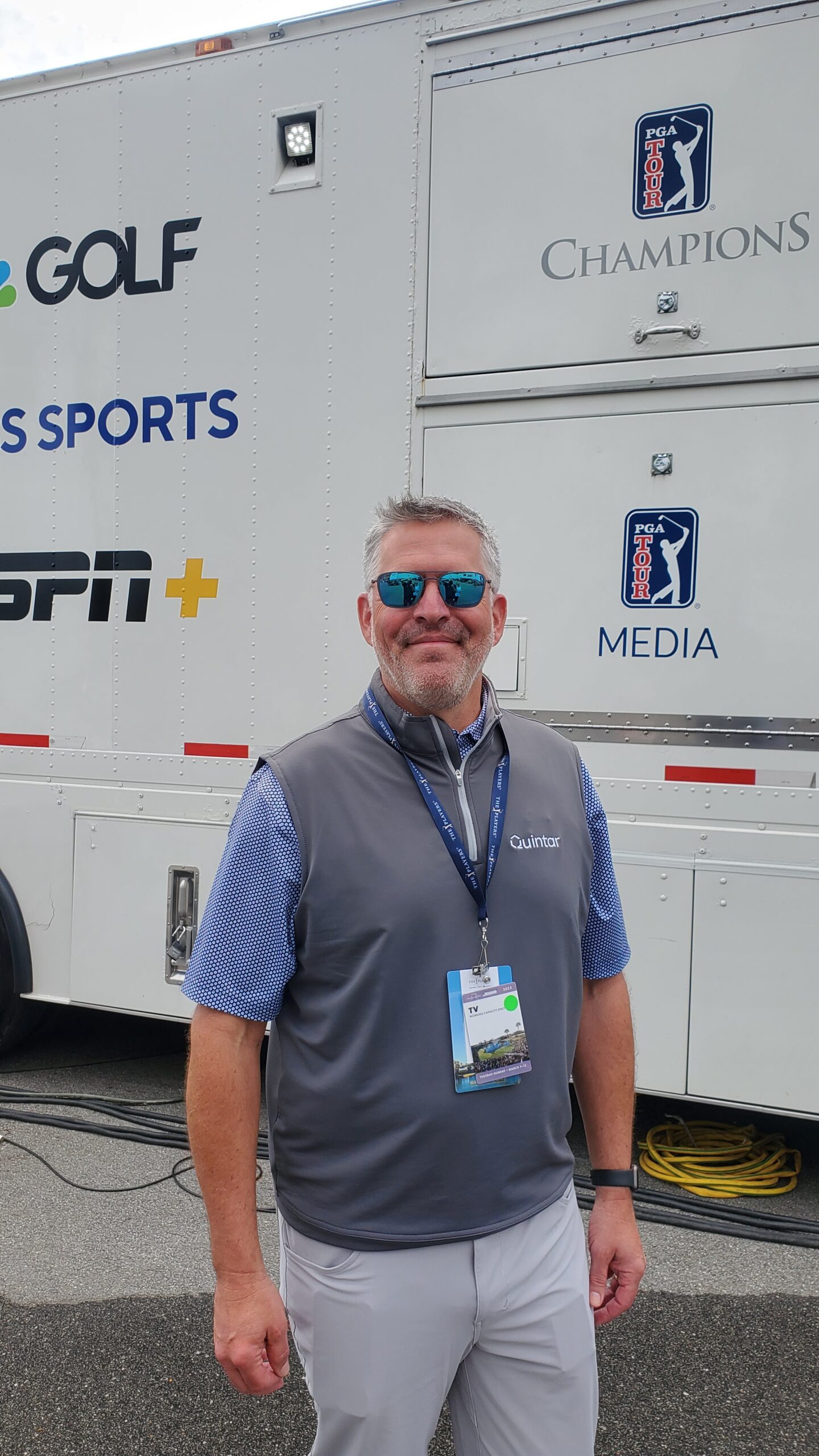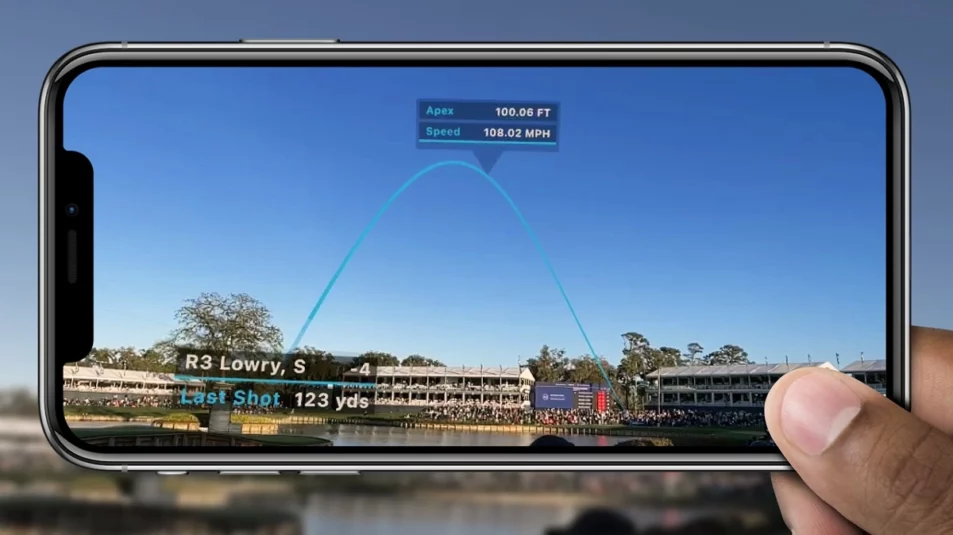Live From THE PLAYERS Championship: Quintar’s Jeff Jonas on How AR Enhances the Golf Fan Experience
The fan-technology company aims to license its platform to content creators
Story Highlights
At the PLAYERS Championship, fans who have an Apple iPhone with AR capabilities are in for a treat. On Holes 16, 17, and 18, the PGA TOUR has deployed an AR platform that allows fans to hold their phone to a hole and see virtual flightpaths of shots on it. They can get caught up on action they might have missed, compare longest drives, and see how players played the hole.
The AR efforts have been built on Quintar’s platform, and SVG sat down with Quintar co-founder Jeff Jonas — who has been EVP at Sportvision (1999-2016) and managing director, global business development, at Intel Sports (2016-21) — to discuss this year’s deployment and the future of AR and Quintar.
Walk us through how you got to this point, with an AR service launched on Holes 16, 17, and 18 here at the PLAYERS Championship?
We started about two years ago, and [Quintar] co-founder Jay Jayaram and I were looking to do something new. We read an article about the coming hardware wars in AR between Microsoft, Apple, Google, and Snap and how they were all going to be butting heads. The article didn’t discuss content. When I was at Sportvision and doing 3D 1st & Ten lines for ESPN for 3D television, it was fantastic. But there wasn’t enough 3D content, and no one bought into 3D. This is kind of the same thing: someone’s going to need help build this platform and develop compelling content for AR.
What kind of content do you think needs to be created?
The things that work for technology, especially in sports, either have utility or [provide] entertainment. I go back to the 1st & Ten line because that had both: it had utility, and it made the game more entertaining because you could see data in the video and know where the team was trying to get the ball. In AR, we didn’t see anything like that, so we felt, Let’s build this platform that will enable people to create content in AR that’s meaningful.
What’s at the core of the platform from a production, a programming, and a technology standpoint?
We figured out how to — what we call it — register large places: when you bring your camera or your phone out, it knows exactly where you’re looking all the time. If you can do that, then you can start putting accurate features in that video.
I like to say it’s like people have tried to do AR before with GPS and GPS is not that accurate: something could be placed 5 ft. this way or 10 ft. that way. Therefore, whatever I try to put in AR could be off by a number of feet. Someone had to solve for that, and that’s what we do at the venue.
Does that require placing technology on the course?
No, this is all machine learning, computer vision, and AI. It keeps learning and keeps getting better, which is kind of the exciting part that wasn’t there at the time I was doing other stuff. There are things being done without human intervention, which is pretty cool. Once you’re able to do that, you enable a lot of things. For example, we’re seeing the ShotLink data, which is content. But then, we can borrow from other AR platforms.
I like to talk about Pokemon Go. It’s a free-to-play game that’s generating $900 million of revenue from advertising and merchandising, from customization. In sports, if we can enable venues to do AR, you have avid fans that can take part in that same type of thing. You can imagine a future where there’s merchandising, there’s advertising, there’s customization, there’s sports betting. But you need that platform to be there first for that to work.
Walk me through the machine learning. If you go to a new course, how does the process of learning the course begin?
We have a fairly simple survey process: we go and take some pictures. That’s the easy part. Once we have that survey, the magic starts happening. The actual work starts happening with the engineers. The engineers create a 3D map of the area and do all kind of things that I’m not privy to because I’m not an engineer.
The cool thing about what we’re doing is that, when people use the app, they’re actually taking pictures the whole time. We can crowdsource some of that, so our surveys get better and better and better over time. Here at TPC, there can be 30,000 people on 17 using the app, and we’re getting 30,000 pictures per second. That helps our system learn.
Over the years, efforts like this have involved apps. Do you have an app?
We have no desire to be an app company. What we want to do is take our SDK [software-development kit] and license that to people. Our theory is, there are people that know how to create content already — like a lot of the people in this compound — but no one’s producing golf content in AR because there’s no platform. What we want to do is, basically, give that platform to content creators and let them go nuts.
This week, we’re being integrated into the PGA TOUR app for the first time; the AR app used to be a standalone app. That’s big because of the audience [the PGA TOUR has].
We were talking with Tom Sahara, your SVP of production technologies, about whether this is meant to be used live, like holding up your phone while the players are hitting, or as a replay device. He said the focus is the latter. Can you explain why that is a more compelling experience?
We think it’s most effective as a second-screen experience. A lot of leagues want to encourage people to go to their venues and events, and those fans are looking for things that are more interactive. AR does that. Here at the PLAYERS, I can sit on the 17th hole and watch, but it can be hard to see who is on the tee box. If you can complement the live in-person viewing experience with more information, it’s interactive and enjoyable.
What is an example of a great use case?
It’s the final round on Sunday, and you can actually see all of the shots a player took at that hole in all the rounds. You can see exactly how he has played that hole all days, and you can see who he’s playing against and how they’ve played that hole all four days. That by itself is pretty cool because you wouldn’t be able to see that unless you could watch videos, and that takes you away from watching the event.
What do you think the key is to raising awareness of AR services like this and getting fans accustomed to turning it on and getting engaged?
People are getting more and more used to using their phone in this capacity. Take Google Maps. What Google’s doing now is putting the map in video. So, number one, this type of thing is becoming more normative.
Number two is what we’re doing here with the PGA TOUR app. It’s a matter of how you start pushing them towards that experience. I do think, once people use it, if it has utility and entertainment, they’ll come back. I think that’s what Pokemon Go has shown us.
What is your business model, and how does someone begin the conversation with Quintar for deployment?
The end goal is to license our SDK. A lot of our deals are more custom deals. We work with people and figure out what’s right for them; it’s usually based on a season and things like how many events and all that kind of stuff. It’s kind of a customized business model for now, but, eventually, we just want to license our SDK.
It’s similar in theory to what Dolby does, making a licensing deal and allowing the customer to take it from there.
Dolby is a great analogy.
What are some misconceptions about AR and the consumer experience? It tends to get lumped in with VR or things like the Metaverse.
Let’s start with the Metaverse. I don’t personally believe that people want to live inside a computer all day. I think people want to live in real life. The beautiful thing is, we’re just making that better. We want you to go to the venue or even stay at home, but we want to make the event better.
I do think a lot of people think they have to have a headset to do AR, but you don’t as mobile AR like what we are doing is very effective. And, when we do get to headset AR, it’s going to be awesome because I can be talking to you with AR glasses and have AR going on and you wouldn’t even know. That will be cool when it happens.
What is the plan for next year here at the PLAYERS and for the rest of this year at other tournaments?
The plan is to eventually get to all holes. That’s clearly what the TOUR wants to do, and it is clearly what we want to do. But we have to be smart about how we get there as there are some challenges to doing that. But, by the end of this year, we’re trying to get to at least six holes on selected tournaments.


